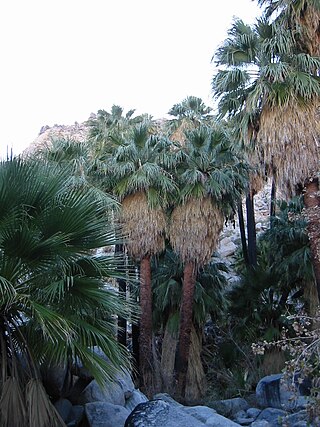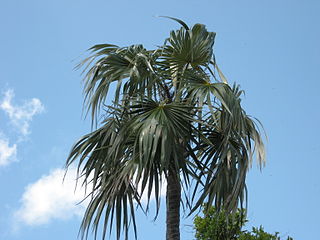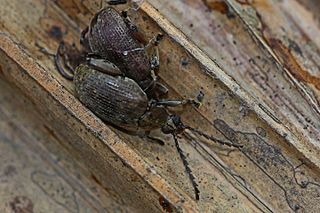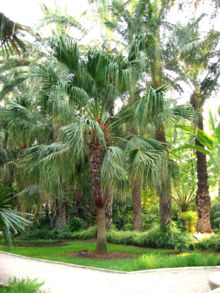
Jasmine is a genus of shrubs and vines in the olive family of Oleaceae. It contains around 200 species native to tropical and warm temperate regions of Eurasia, Africa, and Oceania. Jasmines are widely cultivated for the characteristic fragrance of their flowers. Additionally a number of unrelated species of plants or flowers contain the word "jasmine" in their common names.

Ficus microcarpa, also known as Chinese banyan, Malayan banyan, Indian laurel, curtain fig, or gajumaru (ガジュマル), is a tree in the fig family Moraceae. It is native in a range from China through tropical Asia and the Caroline Islands to Australia. It is widely planted as a shade tree and frequently misidentified as F. retusa or as F. nitida.

Trachycarpus fortunei, the Chinese windmill palm, windmill palm or Chusan palm, is a species of hardy evergreen palm tree in the family Arecaceae, native to parts of China, Japan, Myanmar and India.

Pistacia chinensis, the Chinese pistache, is a small to medium-sized tree in the genus Pistacia in the cashew family Anacardiaceae, native to central and western China. This species is planted as a street tree in temperate areas worldwide due to its attractive fruit and autumn foliage.

Cornus kousa is a small deciduous tree 8–12 m (26–39 ft) tall, in the flowering plant family Cornaceae. Common names include kousa, kousa dogwood, Chinese dogwood, Korean dogwood, and Japanese dogwood. Synonyms are Benthamia kousa and Cynoxylon kousa. It is a plant native to East Asia including Korea, China and Japan. Widely cultivated as an ornamental, it is naturalized in New York State.

The Chavez Ravine Arboretum, in Elysian Park, just north of Dodger Stadium, at 1025 Elysian Park Dr, Los Angeles, California, contains more than 100 varieties of trees from around the world, including what are believed to be the oldest and largest Cape Chestnut, Kauri, and Tipu trees in the United States. Admission to the arboretum is free.

Washingtonia filifera, the desert fan palm, California fan palm, or California palm, is a flowering plant in the palm family Arecaceae, native to the far southwestern United States and Baja California, Mexico. Growing to 15–20 m (49–66 ft) tall by 3–6 m (10–20 ft) broad, it is an evergreen monocot with a tree-like growth habit. It has a sturdy, columnar trunk and waxy, fan-shaped (palmate) leaves.

Pandanus tectorius is a species of Pandanus (screwpine) that is native to Malesia, Papuasia, eastern Australia, and the Pacific Islands. It grows in the coastal lowlands typically near the edge of the ocean. Common names in English include thatch screwpine, Tahitian screwpine, hala tree and pandanus. The fruit is edible and sometimes known as hala fruit.

Camphora officinarum is a species of evergreen tree that is commonly known under the names camphor tree, camphorwood or camphor laurel.

Livistona is a genus of palms, the botanical family Arecaceae, native to southeastern and eastern Asia, Australasia, and the Horn of Africa. They are fan palms, the leaves with an armed petiole terminating in a rounded, costapalmate fan of numerous leaflets.

Pritchardia remota, the Nihoa pritchardia, Nihoa fan palm, or Loulu, is a species of palm endemic on the island of Nihoa, Hawaiʻi, and later transplanted to the island of Laysan. It is a smaller tree than most other species of Pritchardia, typically reaching only 4–5 metres (13–16 ft) tall and with a trunk diameter of 15 centimetres (5.9 in). It is the only type of tree on the island and used to be abundant. In 1885 a wildfire ravaged the island, destroying most of the palms. Only about 700 of these trees remain, making the species endangered but numbers are slowly increasing. The palm is being cultivated in botanical gardens.

Coccothrinax argentata, commonly called the Florida silver palm, is a species of palm tree. It is native to south Florida, southeast Mexico, Colombia and to the West Indies, where it is found in the Bahamas, the southwest Caribbean and the Turks and Caicos Islands. Its natural habitat is rocky, calcareous soil in coastal scrubland and hammock communities.

The Jardin de l'État, formerly known as the Jardin du Roy, is a historic botanical garden on the island of Réunion, found in the capital Saint-Denis.

Saribus rotundifolius, also known as the footstool palm, is a common fan palm found in Southeast Asia. It is a member of the genus Saribus.

Plumeria rubra is a deciduous plant species belonging to the genus Plumeria. Originally native to Mexico, Central America, Colombia and Venezuela, it has been widely cultivated in subtropical and tropical climates worldwide and is a popular garden and park plant, as well as being used in temples and cemeteries. It grows as a spreading tree to 7–8 m (23–26 ft) high and wide, and is flushed with fragrant flowers of shades of pink, white and yellow over the summer and autumn.
L. chinensis may refer to:

Caryobruchus gleditsiae is a species of beetle in the family Chrysomelidae. It lives in North and Central America and develops inside the seeds of palm trees. Adults grow to a maximum length of 11 mm (0.43 in), the size depending on the size of the seed it grew up in. The species was first described by Carl Linnaeus in his 1763 Centuria Insectorum.

The Anna Scripps Whitcomb Conservatory is a greenhouse and a botanical garden located on Belle Isle, a 982-acre (397-hectare) island park located on the Detroit River within Detroit, Michigan. While located near the Canada–United States border, the island is entirely within the U.S. The park itself consists of 13 acres of preserved land for the conservatory and its botanical garden.

Saribus woodfordii is a species of fan palm which is native to an area from southeastern Papua New Guinea to the Solomon Islands.



















